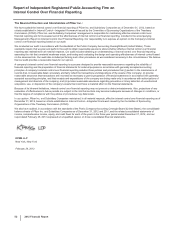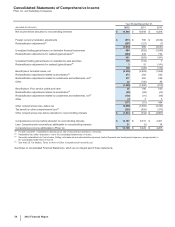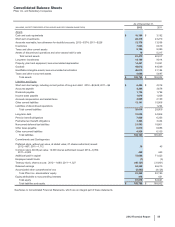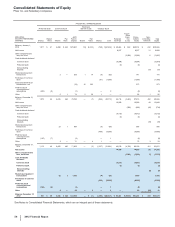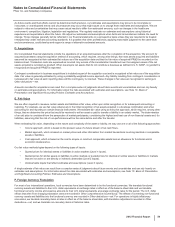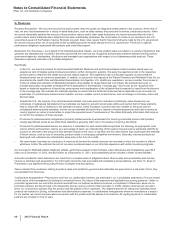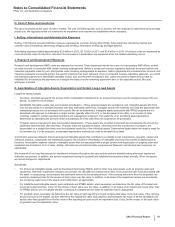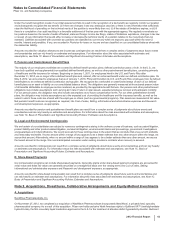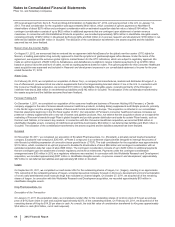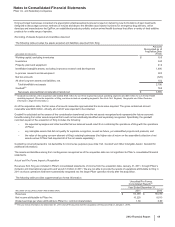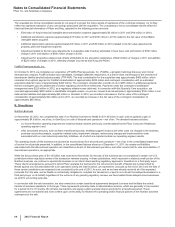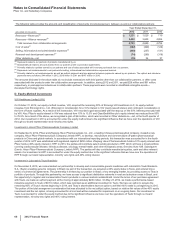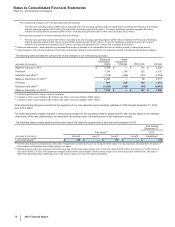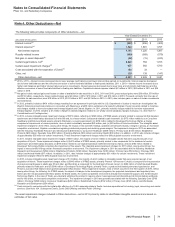Pfizer 2012 Annual Report Download - page 63
Download and view the complete annual report
Please find page 63 of the 2012 Pfizer annual report below. You can navigate through the pages in the report by either clicking on the pages listed below, or by using the keyword search tool below to find specific information within the annual report.
Notes to Consolidated Financial Statements
Pfizer Inc. and Subsidiary Companies
62
2012 Financial Report
Impairment reviews can involve a complex series of judgments about future events and uncertainties and can rely heavily on estimates and
assumptions. For information about the risks associated with estimates and assumptions, see Note 1C. Basis of Presentation and Significant
Accounting Policies: Estimates and Assumptions.
L. Restructuring Charges and Certain Acquisition-Related Costs
We may incur restructuring charges in connection with acquisitions when we implement plans to restructure and integrate the acquired
operations or in connection with our cost-reduction and productivity initiatives. Included in Restructuring charges and certain acquisition-
related costs are all restructuring charges, as well as certain other costs associated with acquiring and integrating an acquired business. (If the
restructuring action results in a change in the estimated useful life of an asset, that incremental impact is classified in Cost of sales, Selling,
informational and administrative expenses and Research and development expenses, as appropriate). Termination costs are a significant
component of our restructuring charges and are generally recorded when the actions are probable and estimable. Transaction costs, such as
banking, legal, accounting and other costs incurred in connection with a business acquisition are expensed as incurred.
Amounts recorded for restructuring charges and other associated costs can result from a complex series of judgments about future events and
uncertainties and can rely heavily on estimates and assumptions. For information about the risks associated with estimates and assumptions,
see Note 1C. Basis of Presentation and Significant Accounting Policies: Estimates and Assumptions.
M. Cash Equivalents and Statement of Cash Flows
Cash equivalents include items almost as liquid as cash, such as certificates of deposit and time deposits with maturity periods of three
months or less when purchased. If items meeting this definition are part of a larger investment pool, we classify them as Short-term
investments.
Cash flows associated with financial instruments designated as fair value or cash flow hedges may be included in operating, investing or
financing activities, depending on the classification of the items being hedged. Cash flows associated with financial instruments designated as
net investment hedges are classified according to the nature of the hedge instrument. Cash flows associated with financial instruments that do
not qualify for hedge accounting treatment are classified according to their purpose and accounting nature.
N. Investments and Derivative Financial Instruments
Many, but not all, of our financial instruments are carried at fair value. For example, substantially all of our cash equivalents, short-term
investments and long-term investments are classified as available-for-sale securities and are carried at fair value, with changes in unrealized
gains and losses, net of tax, reported in Other comprehensive loss (see Note 6. Accumulated Other Comprehensive Loss, Excluding
Noncontrolling Interests). Derivative financial instruments are carried at fair value in various balance sheet categories (see Note 7A. Financial
Instruments: Selected Financial Assets and Liabilities), with changes in fair value reported in current earnings or deferred for qualifying
hedging relationships. Virtually all of our valuation measurements for investments and derivative financial instruments are based on the use of
quoted prices for similar instruments in active markets, or quoted prices for identical or similar instruments in markets that are not active or are
directly or indirectly observable.
Realized gains or losses on sales of investments are determined by using the specific identification cost method.
Investments where we have significant influence over the financial and operating policies of the investee are accounted for under the equity
method. Under the equity method, we record our share of the investee's income and expenses, in Other deductions—net. The excess of the
cost of the investment over our share of the equity of the investee as of the acquisition date is allocated to the identifiable assets of the
investee, with any remaining allocated to goodwill. Such investments are initially recorded at cost, which typically does not include amounts of
contingent consideration.
We regularly evaluate all of our financial assets for impairment. For investments in debt and equity securities, when a decline in fair value, if
any, is determined to be other-than-temporary, an impairment charge is recorded in the statement of income, and a new cost basis in the
investment is established.
Impairment reviews can involve a complex series of judgments about future events and uncertainties and can rely heavily on estimates and
assumptions. For information about the risks associated with estimates and assumptions, see Note 1C. Basis of Presentation and Significant
Accounting Policies: Estimates and Assumptions.
O. Deferred Tax Assets and Liabilities and Income Tax Contingencies
Deferred tax assets and liabilities are recognized for the expected future tax consequences of differences between the financial reporting and
tax bases of assets and liabilities using enacted tax rates and laws. We provide a valuation allowance when we believe that our deferred tax
assets are not recoverable based on an assessment of estimated future taxable income that incorporates ongoing, prudent and feasible tax-
planning strategies.
We account for income tax contingencies using a benefit recognition model. If we consider that a tax position is more likely than not to be
sustained upon audit, based solely on the technical merits of the position, we recognize the benefit. We measure the benefit by determining
the amount that is greater than 50% likely of being realized upon settlement, presuming that the tax position is examined by the appropriate
taxing authority that has full knowledge of all relevant information.


